How the GOP Gamed the Voting System to Dominate and Why Elections Are an Anti-Democratic Mess
Two months to elections and counting. Americans will be voting for the entire House, a third of the Senate and the president, as well as all members of state legislative lower houses and usually half of their state senators.
It may be an historic election, an election in which many states will be operating under rules adopted only in the last half dozen years. These rules affect the value of one’s vote and the ease of voting. All of this is occurring in a setting where fewer and fewer federal races are even competitive. Together these impose considerable challenges for those trying to dislodge incumbents, the success of which may depend significantly on the level of voter turnout.
Voter dilution, voter suppression, turnout, the dwindling number of winnable seats: These four key factors will influence the outcome of the 2016 election and determine the future composition of the federal government.
1. Voter Dilution
Every 10 years, per the U.S. Constitution, the number of representatives allocated to each state is determined based on the U.S. Census. The Constitution largely, although not entirely, leaves the manner in which those representatives are elected to the states—and that has left room for manipulation of voting districts to benefit one party or another, also known as gerrymandering.
Gerrymandering is not new. Indeed, the word is more than 200 years old, a combination of the name of a former governor of Massachusetts, Eldridge Gerry, whose party redistricted the state in 1812, and the animal the resulting map of Essex County looked like—a salamander.
The advent of computers in the 1980s made it easier to fine-tune redistricting efforts for partisan purposes, and in the 1990s and 2000s, a wealth of new, easily accessible personal data enabled the creation of detailed voter profiles on a street-by-street, block-by-block basis. As one judge has commented, “Today, modern computer mapping allows for gerrymandering on steroids, as political mapmakers can easily identify individual registrations on a house-by-house basis, mapping their way to victory.”
The next evolution in the redistricting process occurred in 2010 after a handsomely financed and well-coordinated Republican effort to capture state legislative seats proved wildly successful. Going into the election, Democrats held a 60-36 advantage in state legislative chambers. After the election, the legislative advantage dramatically shifted to the Republicans 57-39.
The winners immediately set themselves the task of ensuring permanent control. David Daley, former editor in chief of Salon, explains how in his new book, Ratf**cked: The True Story Behind the Secret Plan to Steal America’s Democracy. The effort, fittingly called REDMAP (Redistricting Majority Project), involved the Republican Governors Association, U.S. Chamber of Commerce and ALEC, with funding by Walmart, tobacco companies and individual millionaires and billionaires. Their tool was an unprecedentedly finely detailed computer model.
The shape of gerrymandered districts were at times bizarre. Consider this map of the 7th Congressional District in Pennsylvania.
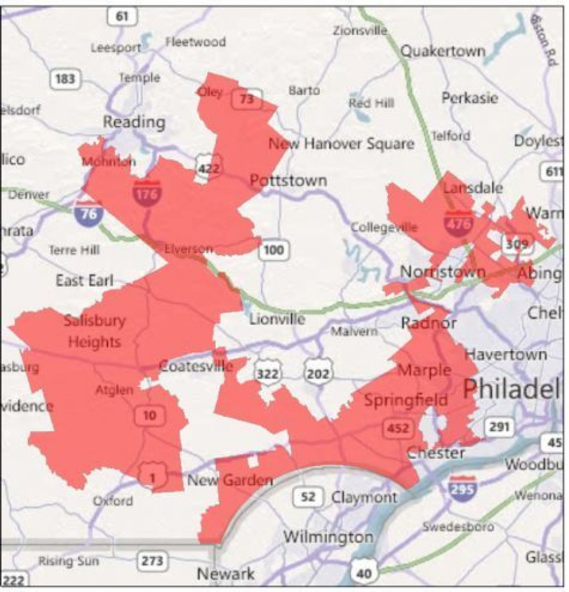
The dramatic voter dilution resulting from redistricting has led one federal judge to lament, “the fundamental principle of the voters choosing their representative has nearly vanished. Instead, representatives choose their voters.”
The effects of the post-2010 redistricting have been dramatic. Until 2010, Ohio congressional districts were roughly evenly divided between the two parties. In 2012, while Ohioans cast 52 percent of their votes for Republican congressmen, their House delegation was 75 percent Republican.
In Pennsylvania, Democratic candidates for the House received half the votes, but Republicans won three-quarters of the congressional seats. More than half the voters in North Carolina voted for Democrats, yet Republicans filled about 70 percent of the seats. Democrats drew more votes in Michigan than Republicans, but took only five out of the state’s 14 congressional seats.
Right after the 2012 election, Mother Jones published a visually instructive chart comparing the percentage of House seats won by each party to the percentage of the popular vote that party won. A fair election would be one where the light red line was roughly the same length as the dark red line.
Republican Gerrymandering and the 2012 Election
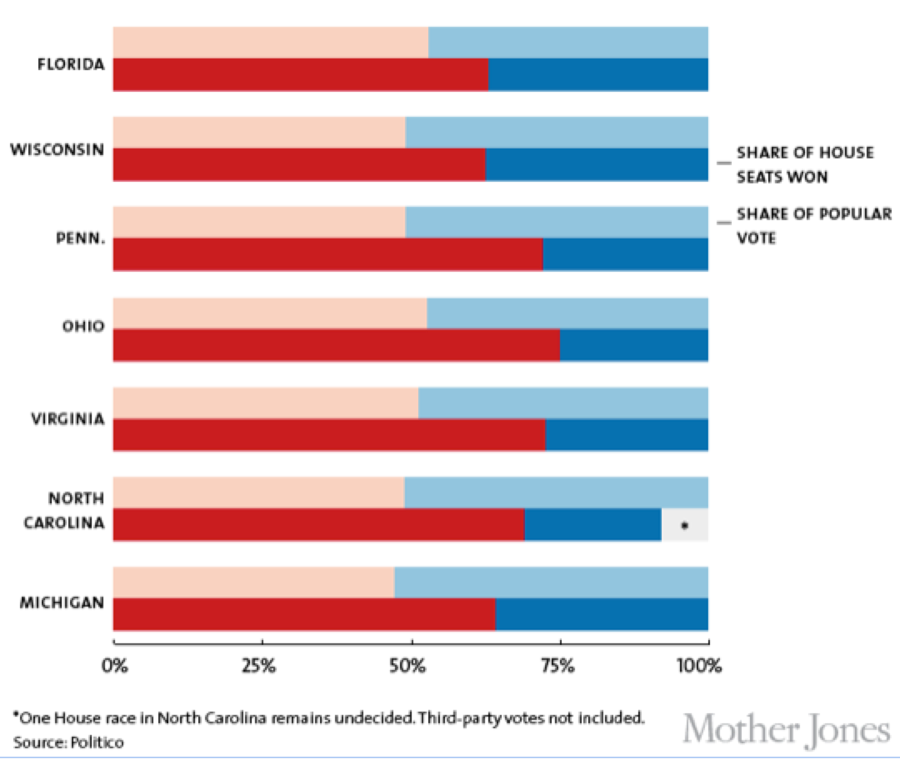
Another way to look at this is that in Pennsylvania, Ohio and Virginia, one Republican vote had the same voting impact as 2.5 Democratic votes. In North Carolina, the ratio was 3:1.
Republicans were masters of the art of gerrymandering, but when Democrats had the opportunity, they didn’t hesitate to use similar techniques, although they were unable to achieve the ultimate magic trick of converting a minority of the popular vote into a majority of House seats. In Maryland, Democrats won 62 percent of the combined votes for Congress and 88 percent of the seats. In Illinois, they won 54 percent of the popular vote and 66 percent of the seats.
Democrat Gerrymandering and the 2012 Election

Federal courts have been reticent to intervene in state redistricting disputes. Even when they do, the impact is delayed and often modest. North Carolina’s gerrymandered maps were drawn in 2011, but it wasn’t until February 2016 that a federal court overturned them. In the interval, the state had two congressional elections. As ThinkProgress observes, “the message to lawmakers is clear: go ahead and draw the most self-serving maps you can manage, because even if they are struck down it will take the courts years to do so."
Within a few days of the court’s decision, the North Carolina legislature convened a special session and promptly redrew the map in a way only marginally better than the previous one. Again a lawsuit was filed. In June 2016, the same federal court that had found North Carolina’s redistricting racially biased in February refused to intercede. The judges did note the declaration of one of the key legislators: “e want to make clear that we are going to use political data in drawing this map. It is to gain partisan advantage on the map. I want that criteria to be clearly stated and understood. I’m making clear that our intent is to use the political data we have to our partisan advantage.” And the judges did not hide their distress: “The Court is very troubled by these representations.” Troubled but powerless, they insisted. “Nevertheless, it is unclear whether a partisan-gerrymander claim is judiciable given existing precedent.” Based on precedent, “the Court’s hands appear to be tied.”
Given the aftermath of the 2010 election, state legislative elections in 2018 and 2020 promise to be bitterly contested. Spending in 2018 may reach levels reached only in presidential election years.
For those wanting to bring fairness to the redistricting process, a non-judicial remedy may be available. Take control out of the hands of self-serving legislators and parties and invest it in nonpartisan citizen commissions. In the 14 states that have direct initiatives, this can be accomplished by a majority statewide vote, as has already occurred in California and Arizona. In 2015, by a 5-4 decision, the Supreme Court upheld Arizonans' right to do this. An independent assessment of the impact of California’s independent commission found that the process elicited broad bipartisan support and resulted in many more competitive legislative races. Five other states have semi-independent commissions: Washington, Idaho, Montana, Hawaii and New Jersey.
Whatever happens, at least the next two elections should be guided by the political maxim: Vote for your local state legislator as if the Congress of the United States depended on it. Because it will.
2. Voter Suppression
In 2008, the Supreme Court upheld an Indiana law requiring all voters casting a ballot in person to present a U.S. or Indiana photo ID. The facts were not in dispute. Those least likely to have state-issued identification were disproportionately poor and nonwhite. The only voter fraud addressed by photo IDs is voter impersonation fraud, which was practically nonexistent.
None of this mattered to the justices. John Paul Stevens, writing for the majority, insisted the burden of proof rested not on the state to justify new voting restrictions but on the citizenry to prove they created a burden. Moreover, the burden had to be extensive and widely shared. He elaborated, “Even assuming that the burden may not be justified as to a few voters, that conclusion is by no means sufficient to establish petitioners’ right to the relief they seek.”
The decision reversed a century-old dynamic in America during which the franchise had been regularly broadened and the ability to vote regularly facilitated.
Since 2010, 23 states have either introduced more restrictive voter procedures or tightened those in operation.
In 2013, the Supreme Court, by a 5-4 decision, further enabled disenfranchisement by striking down the heart of the Voting Rights Act of 1965, the provision that required pre-approval by the federal government of changes in election laws. This freed the nine covered states and dozens of counties in New York, California and South Dakota to change election laws without advance federal approval. They can still be sued, but only after the fact.
Five new voter suppression laws enacted by states were in place for the 2012 presidential election. Fifteen more laws will be tested for the first time in the 2016 elections. Seven of these enacted their laws after the Supreme Court eliminated the need for pre-clearance.
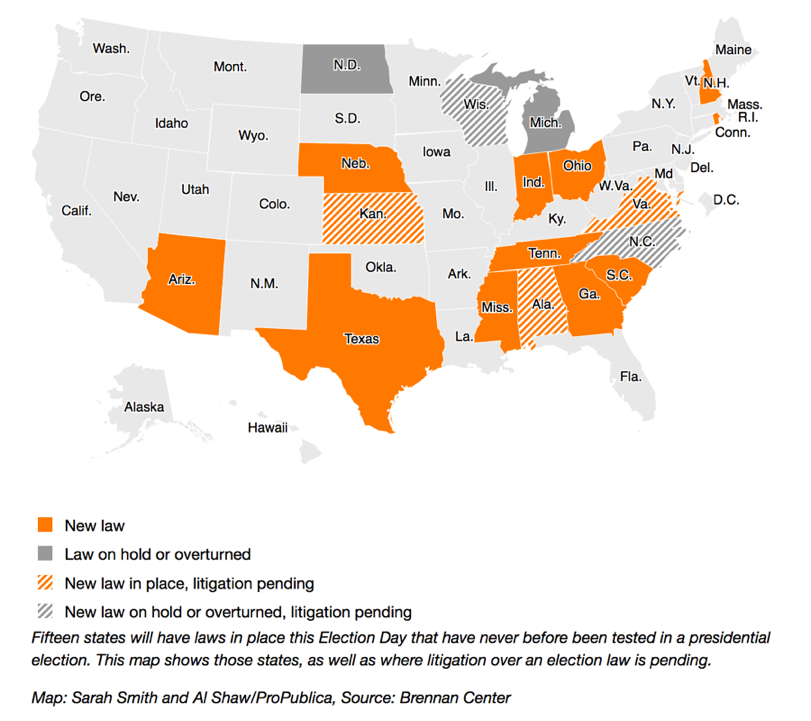
Since 2013, suits regarding these laws have been wending their way through the courts. Early this summer, courts halted the implementation of voter suppression laws in North Dakota and North Carolina.
North Carolina’s voting restrictions, introduced the day after the 2013 Supreme Court decision, added a strict photo-ID requirement, cut a week off of early voting, and ended same-day registration, preregistration and out-of-precinct voting. A Circuit Court upended the stricter voting requirements, concluding the law’s provisions “target African Americans with almost surgical precision,” and explained, “We can only conclude that the North Carolina General Assembly enacted the challenged provisions of the law with discriminatory intent.” On August 31, the Supreme Court, without Justice Scalia, affirmed the Circuit Court decision by a 4-4 tie vote.
The status of all these lawsuits, as of mid-August, can be found at ProPublica.
3. Voter Turnout
Voter dilution makes it extremely difficult, although not impossible, to capture congressional and state legislative seats. Voter suppression aids and abets the impact of voter dilution but also affects the capacity to win statewide elections for statewide offices, senators and the president. Both obstacles can be overcome, at considerable expense and effort, by increasing the number of people who vote.
When it comes to voter turnout, history is clear. When turnout is high, Democrats win. When turnout is low, Republicans win.
Voter turnout for presidential elections, according to the Census Bureau, has remained fairly stable over the last generation, while voting for congressional races has declined.
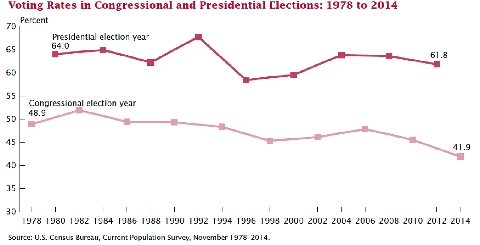
In 2014, low voter turnout among groups that tend to vote Democrat may have been decisive in expanding Republican control of Congress. Overall voter turnout was 36.3 percent, the lowest percentage since 1942, when millions of men were off to war. Voter turnout among 18-to-29-year-olds dropped to 19.9 percent, the lowest total ever recorded in federal elections, and voter registration among the youth fell to 46.7 percent, the lowest in 40 years.
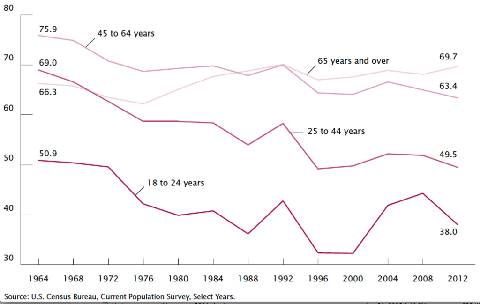
There has been a steady decline in voter turnout for all groups, except those age 65 and over. In presidential elections, turnout of those over 65 has actually gone up since the 1960s and has stabilized at high levels since the early 1990s. It is unlikely that turnout can be increased among this group, but there has been a considerable variability in which party they vote for. They had reliably voted Democrat but switched to the Republican column in 2012, and currently their vote appears up for grabs.
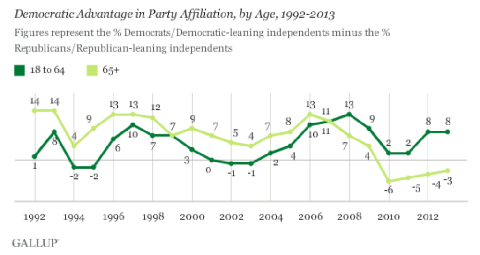
There has also been a dramatic variability in voter turnout for those 18-24 years of age. One might interpret the increase and decrease in turnout in the 1990s as youth voting enthusiastically for Bill Clinton and then becoming so disillusioned that turnout plunged in the succeeding two elections. A massive get-out-the-vote campaign focused on youth in 2004 may be the reason behind the rebound. In 2008, a substantial youth turnout was an important reason for Barack Obama’s election. In 2016, the level of turnout among young voters could determine the presidency.
Another way of breaking down voting patterns is to compare a cohort’s share of the eligible voting age population with its share of those actually voting. What we discover, perhaps not surprisingly, is that young voters lag, while those 45-64 punch high above their weight class, even more so than those 65 and older. Voting rates for those age 30-44 are only slightly below their percentage of the eligible voting population.
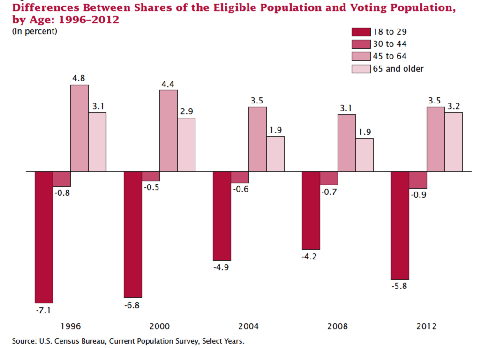
When we examine the impact of race and ethnicity on voting, we find that black turnout has risen steadily over the past 20 years, hitting a peak with Obama’s two presidential runs. Hispanic and Asian turnout, on the other hand, has not risen much and lags far behind that of blacks and non-Hispanic whites.
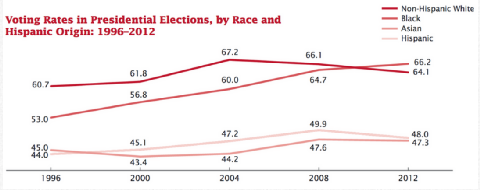
If we compare the share of the eligible voting population with the share of actual voters, non-Hispanic whites are disproportionately represented while Hispanics are disproportionately underrepresented.
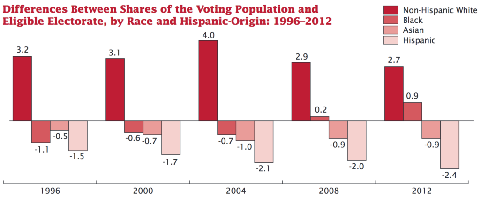
4. How Many Races Truly Are in Play?
The presidency may well be won on turnout, and it is conceivable that a high turnout will allow the Democratic Party to take over the Senate, and more remotely, the House. But high turnout is a decreasing factor in many races.
In 1992, according to Nate Silver, 103 House races were competitive; in 2012 this had plunged to only 35. Meanwhile, the number of landslide districts in which the presidential vote margin deviated by at least 20 percentage points from the national result has roughly doubled, from 123 in 1992 to 242 in 2012.
In the 2016 race, 270towin.com estimates, only 50 House seats out of 483 are competitive: 38 are held by Republicans and 12 by Democrats. The map starkly reveals the paltry number of competitive seats. Given that Democrats will need to add 31 seats to gain a majority, their chances are extremely slim.
Where House Seats Are Winnable
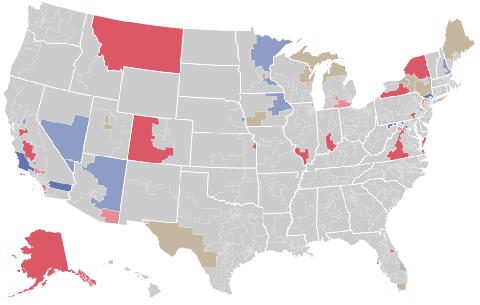
For the Senate, 11 seats (tan states) are considered competitive. Democrats need four additional seats for a 50-50 tie that can be broken by the vice president or five for an outright majority.
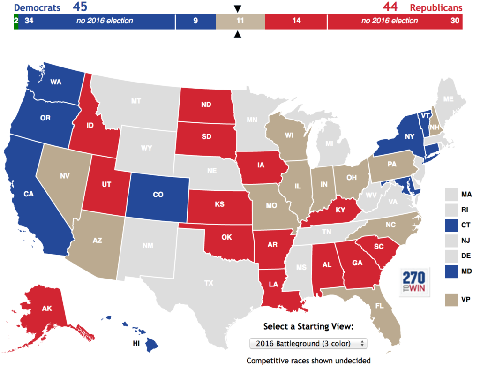
So what does all this tell us? The system indeed is rigged, but that doesn’t make elections impossible to win. The key, at least for Democrats, is to increase turnout. One part of that strategy is to overturn state laws that suppress turnout. For Democrats, winning the presidency and winning back the Senate will require a massive get-out-the-vote effort on behalf of their candidates, especially targeting the young and Hispanics. A massive effort would almost surely be insufficient to take back control of the House, but it could make the margin much, much closer. For Republicans, a low turnout guarantees the status quo in Congress and may well gain them the presidency.
David Morris is co-founder of the Institute for Local Self-Reliance and directs its initiative on The Public Good. He is the author of "New City States" and four other non-fiction books. Follow him on Twitter: @PublicMorris.
This article was made possible by the readers and supporters of AlterNet.


Spread the word